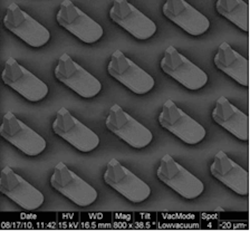Cascade Microtech, imec develop automatic probe system for 3D chips
Leuven, Belgium. Imec and Cascade Microtech, a FormFactor company, have announced the successful development of a fully automatic system for pre-bond testing of advanced 3D chips. Pre-bond testing is important to increase the yield of 3D stacked chips. The new system enables probing and hence testing of chips with large arrays of 40-µm-pitch micro-bumps on 300-mm wafers. The relevance of this new tool is underlined by the companies’ entry, titled “Probing of Large-Array, Fine-Pitch Microbumps for 3D ICs,” winning the “Electronics and Semiconductor” 2017 National Instruments Engineering Impact Award last week at NIWeek in Austin, TX.
As an emerging technology, 3D IC stacking still has many open options and technical challenges. One of these challenges is probing of the individual chips, before being stacked, to ensure a good yield of the 3D stacked ICs. The inter-chip connections of 3D stacked ICs are made by large arrays of fine-pitch micro-bumps which makes probing these bumps a challenge. Until today, the probing solution is to add dedicated pre-bond probe pads to the to-be-stacked dies, but this requires extra space and design effort and increases test time.
imec and Cascade Microtech have now developed a fully automatic test cell that can provide test access by probing large arrays of fine-pitch micro-bumps. The system is based on a Cascade Microtech CM300 probe station and National Instruments PXI test instrumentation, complemented by in-house developed software for automatic test generation, data analysis, and visualization. The system allows testing of wafers up to 300-mm diameter, including thinned wafers on tape frame with exposed through-silicon vias. After several years of intense collaboration between imec and Cascade Microtech, partly supported by the EU-funded FP7 SEA4KET project, good results were achieved with Cascade Microtech’s Pyramid Probe prototype RBI probe cards on imec’s 300-mm wafers with 40µm-pitch micro-bumped chips.
“Imec provided us with unique early insights into the test requirements for 3D ICs, which drove the development of this system,” said Jörg Kiesewetter, director of engineering at Cascade Microtech Dresden. “Also the availability of imec’s dedicated micro-bump test wafers has helped us to fine-tune both the probe station and the probe cards for this application.”
“At imec, we are using the system now on a routine basis to test our 40-µm-pitch micro-bumped wafers,” stated Erik Jan Marinissen, principal scientist at imec. “As everything in the semiconductor realm, also micro-bumps are subject to downscaling. Hence, with Cascade, we have started experiments to also probe our 20µm-pitch micro-bump arrays, and those look promising.”
About the Author

Rick Nelson
Contributing Editor
Rick is currently Contributing Technical Editor. He was Executive Editor for EE in 2011-2018. Previously he served on several publications, including EDN and Vision Systems Design, and has received awards for signed editorials from the American Society of Business Publication Editors. He began as a design engineer at General Electric and Litton Industries and earned a BSEE degree from Penn State.



